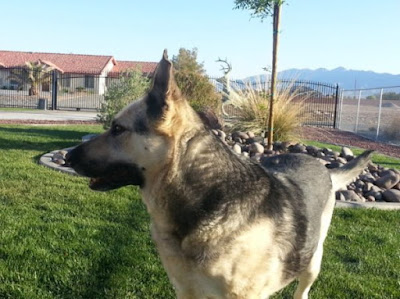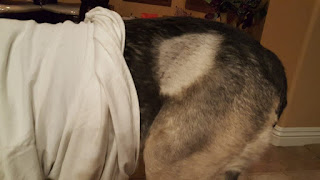Monday, 14 October 2019
Colloidal Silver Helps Heal Dog’s Surgical Wounds
My wife and I have had her for 13 years, and we believe she was probably two years old, or a bit older, when we first found her abandoned in the middle of the Mohave Desert.
So, she’s at least 15 years old now — quite elderly, for a dog.
Surgery for Large, Non-Cancerous Tumors
Lady Belle just went through what the veterinarian called “major surgery” for four non-cancerous tumors that had grown so large beneath the surface of her skin, and had become so uncomfortable, that she’d chewed through her own skin and bitten one open.
So we had no choice but to put her through the surgery to have the fatty tumors removed, even though we felt the surgery could be too dangerous for her, at her age.
Our veterinarian agreed that while she was indeed too old for the surgery, holding off from removing the growing tumors would be equally unwise, and would, in the end, might put her through even more trauma than the surgery would.
Before-and-After Photos Tell the Tale
For the sake of space, in the before-and-after photos below I’m focusing solely on the largest of her four surgical wounds.
The first two photos directly below are “before” photos, showing the large, inflamed, angry-looking surgical wound, replete with stitches.
The third and fourth photos below are “after” photos. The first of these shows how amazingly well that main surgical wound has been healing in less than one week after the surgery. And the second of these show what the surgical wound looks like at two weeks, after the stitches were removed.
Take a gander at the before-and-after photos for yourself, and see why colloidal silver is considered to be such a profound miracle healing substance by so many people.
BEFORE PHOTO #1: Lady Belle’s six-inch surgical wound on the first day of surgery. Note how deep red and “angry” looking the wound is.
BEFORE PHOTO #2: Lady Belle in her full post-surgery regalia with wound showing; i.e., the blue inflatable collar to help keep her from scratching or licking the wounds, and one of my t-shirts to help keep the wound from getting dirty
AFTER PHOTO #1: Above, you can see how astonishingly well the surgical wound is healing after only one week, thanks to the three-time-daily sprays of colloidal silver we’ve been applying, plus giving her a cupful of colloidal silver daily mixed into her water bowl. Note how all of the red, angry skin at the surgical wound site has been healed and is beginning to grow back together.
AFTER PHOTO #2: This photo was taken two weeks after the surgery, the day she got her stitches removed. The wound is completely healed. New hair is growing back in over the relatively minor scar.
We didn’t tell the veterinarian that we’ve been spraying Lady Belle’s surgical wounds with colloidal silver three times a day, and giving her a cup full of colloidal silver mixed into her water bowl each day. But that’s what we attribute Lady Belle’s remarkably fast healing to.
As an aside, Lady Belle also likes it when I spray her front paws with colloidal silver, and allow her to lick the colloidal silver off her paws. In fact, sometimes she’ll come in the house and lay down right next to me, and start licking her paws and then looking at me, as if she’s trying to alert me that she wants some colloidal silver.
When she does that, I go get our pump spray bottle of colloidal silver from the bathroom, and spray some colloidal silver on the tops of her paws. She then licks it all off, and quits.
I’ve always believed dogs (and cats) have an innate ability to sense that colloidal silver is good for them. And often, if any of my pets aren’t feeling well, and I put a bowl of colloidal silver next to their water bowl, they’ll actually go straight for the colloidal silver and skip the water.
Clinical Study: Silver Heals Animal Wounds
According to the clinical researchers behind a study titled “Topical Delivery of Silver Nanoparticles Promotes Wound Healing,” published in the medical journal ChemMedChem:
“We investigated the wound-healing properties of silver nanoparticles in an animal model and found that rapid healing and improved cosmetic appearance occur in a dose-dependent manner…
…we showed that silver nanoparticles exert positive effects through their antimicrobial properties, reduction in wound inflammation, and modulation of fibrogenic cytokines.”
In other words, in a clinical study of animal wounds treated with nanoparticulate colloidal silver, the silver promoted rapid healing, improved the appearance of the wound site, killed microbes and reduced inflammation all at the same time. All of this was in a “dose-dependent manner,” meaning the more silver they used, the better it healed the wounds.
Of course, that’s exactly what my wife and I have witnessed with Lady Belle’s quick recovery from such extensive surgery.
Generally, colloidal silver can simply be put into a pump spray bottle and sprayed lightly onto cuts, scrapes and other wounds four or five times a day.
And if you feel you need to bandage a wound that’s a little more serious than a simple cut or scratch, gauze bandages can be soaked in colloidal silver – or just lightly sprayed with colloidal silver – and applied over wounds. Pet owners say such bandages should be changed out at least three times a day.
Anecdotal Accounts of Wound-Healing for Pets
Of course, for experienced colloidal silver users, healing dogs and cats of their wounds with colloidal silver is nothing new. Here’s what a few people have written in to say:
“One of my other cats had been in a fight. Unknown to me, he developed an abscess. When it finally broke open, it was horrible with nasty green pus coming out of it.
I immediately did a Colloidal Silver wash on it, using a medicine syringe to apply the silver. I did this twice a day for the first few days, along with 1 teaspoon of silver internally twice a day.
I then reduced both treatments to once a day for a few more days. The abscess quickly cleared up and my cat was back in action!”
Another reader, Martin S., wrote in to say:
“I have a friend who’s dog was hit by a car, suffered extensive abrasions and wounds, the vet had him all bandaged up with some kind of salve on him, this was the third week since the accident and to me, it didn’t look like it was healing very well.
I gave him my Colloidal Silver and told him not to put the salve on it and just use the Colloidal Silver, one week and his skin was all scabbed up and looked great, two weeks it was healed.”
Another reader wrote in to say she too had used colloidal silver to help a dog with a non-healing wound:
“I have a friend at work whose dog had a sore that would not heal. She had tried all sorts of things…I made a bottle of silver for her and she just sprayed it all weekend on the sore every chance she could and it healed so fast she couldn’t believe it!”
And another reader wrote to say:
“Our dog tangled with a bear. Its eye was bloody – we sprayed Colloidal Silver – within minutes she was prancing around the barn as if nothing had ever happened. The cow had problems.”
And even another reader wrote to say:
“I have used colloidal silver for myself and my horses, dogs and cats. It has always surpassed the results I was expecting. I was dealing with some awful wounds with the animals and colloidal silver was so incredibly effective with the healing process.”
A long-time colloidal silver users wrote to say:
“By the way, I also use the colloidal silver water on my animals. For example, I have several domestic felines. In the rough-housing and playing, they sometimes get nasty cuts, abrasions and wounds.
Whenever that occurs, these felines are treated with 7-10 ppm colloidal silver water that I make with a Silver Edge Micro-Particle Colloidal Silver Generator. I spray it on their wounds several times a day, and give them several eye-droppers full of colloidal silver, orally, as well.”
Finally, this reader wrote to say:
“I give Colloidal Silver to a friend of mine that has 75 horses. She uses it when any of her horses get bit, kicked, or cut. She loves it. She doesn’t have to call a vet, and I get to help out a friend… If I, or any of my animals, ever get cut or scratched I put Colloidal Silver on it, and usually by the next day healing has begun.”
As you can see, many, many people have experienced great success using colloidal silver to help heal wounds on a variety of pets.
Cured a Cancerous Lesion, as Well!
Furthermore, I received the following extensive testimonial from a woman who used colloidal silver on her 12-year old poodle’s inoperable open cancer wound. Here’s what she had to say:
“My 12 year old poodle, Susie, had a cancerous lesion about three inches wide. She had surgery but the veterinarian said he couldn’t promise anything because they couldn’t get all of the cancer out.
After about six months the cancer grew back again, but this time it was huge. The veterinarian said he couldn’t do anything more. The tumor was too big. They could do expensive radiation, but there was no guarantee of results. The best thing would be to put Susie to sleep, according to the veterinarian.
The cancerous lesion that developed at the site of the tumor soon started getting full of pus and we had to cut away dead, necrotizing flesh every day. You could smell the dead flesh all of the way across the room. Susie was in so much pain she would no longer eat at all, and lost all of her playfulness and looked like she just wanted to die.
That’s when we started using the micro-particle colloidal silver, spraying it directly into the cancerous lesion three times a day.
At first, she started dripping water and blood from the lesion. But slowly, after about a month of the daily colloidal silver treatments, the red, inflamed areas began to heal, the water and blood drippings cleared up, and the cancerous lesion began to close up. There was no more dead flesh, and the awful smell of dead flesh completely went away.
Susie’s pain also seems to have vanished, and she has begun to regain her old playful nature. Plus, she’s regained her appetite with a vengeance. It looks as if the colloidal silver treatment is going to completely heal her at this point.” — Anna J., NV
Subscribe to:
Post Comments (Atom)












No comments:
Post a Comment